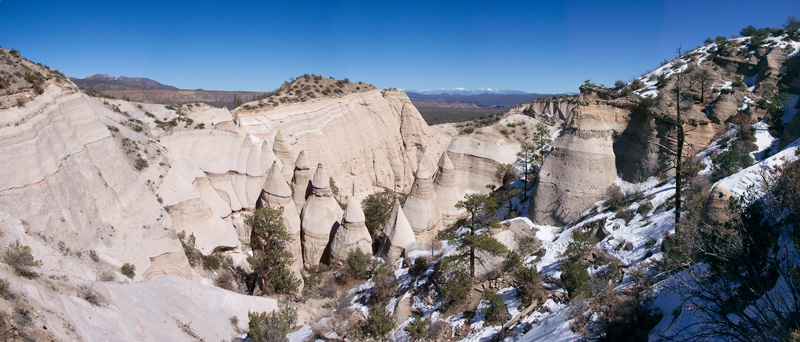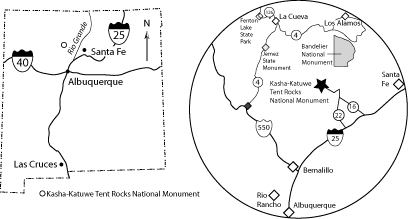Slot Canyon Tent Rocks National Monument
Colored Cliffs and Tent Rocks at Kasha-Katuwe Tent Rocks National Monument
Kasha-Katuwe Tent Rocks National Monument is located just over an hour north of Albuquerque near the Cochiti Pueblo. Kasha-Katuwe meaning 'white cliffs' is a natural formation of weathering and erosion that forms these rocks that resemble cones or tents. The slot canyon trail is approximately 1.5 miles one way and will climb in elevation to. Found in many places in the Southwest United States, slot canyons are formed as water rushes through the rock. The slot canyon at Tent Rock is unique in that it is carved into volcanic ash – or tuff. As we hiked, there were times the slot came to a point beneath our feet — the trail became just wide enough for one shoe. I went on a hike at Kasha-Katuwe Tent Rocks National Monument in New Mexico. This video was captured with my GoPro Hero3 video camera in a first person view.
After a dreary and rainy day, the sun rose behind the hills signaling a warmer day at Pueblo de Cochiti. In the mid-morning, when the temperature rose to about 50ºF, we headed to the nearby Kasha-Katuwe Tent Rocks National Monument for a hike. We were here in April of this year and was captivated by its fairy tale landscape. We came back to revisit it like old friends. The sun cast lights to the multi-colored cliffs behind the drifting clouds from time to time, changing the hues and shades of the cliffs. The fast moving fluffy clouds above the cliffs made this picturesque landscape more dramatic. A small garner snake and a tarantula crossed the trail. What a beautiful day for a hike!


Volcanic eruptions from Jemez spewed rock fragments and ash over here 6 to 7 million years ago. Layers upon layers of volcanic debris deposited here and were fused to rocks. Erosion from water, ice, and wind carved this unique landscape. The Slot Canyon Trail is a one mile trail to the summit. There were several tall ponderosa pine trees in the canyon. An old ponderosa pine has an exposed root system about 6 feet above the ground. At some section, the Slot Canyon is so narrow that only one person can walk through. As I walked through the Slot Canyon, a narrow sunbeam lit up the channel among the towering canyon walls, and a small patch of the sky could be seen above the canyon. Water carried debris down the canyon and carved the walls with grooves and concaves.
Ducked down and went through a wide hole in the canyon, we came out of the narrow section of the canyon. Up on the hillside stood an army of cone shaped tent rocks. Lines, grooves, and holes present on this group of tent rocks. Some of the tent rocks have cap rocks that resist to erosion and protect the rock below. The trail zigzags up the canyon. A couple of cone shaped tent rocks stood right by the trail. Further up, a hoodoo sits on top of a layer cake shaped rock formation. Sometimes the trail narrows to one foot wide.



Climbing up the hill, we observed the giant tent rocks at eye level within short distance. The whimsical shapes of the tent rocks are unique. As we climbed higher, the group of tent rocks in the canyon looked like castles. Cream, tan, and copper colored wavy bands decorate the cliffs. The most difficult part of the trail is a drop about 3 feet tall. Only one person could cross that drop at a time. After that, the trail is on the hillside. Just a short hike up the hill is the summit. The wonderful vista is the reward after walking across the ridge to the tip of the mesa. Looking down there lies the Cave Loop Trail below. Looking to the side are the multi-colored cliffs surrounding the trail. In the distance are Cochiti Lake, Jamaz, and Sandia mountains. On the horizon looms the Sangre De Cristo above Santa Fe.
Sunshine on the Tent Rocks in Slot Canyon
Slot Canyon Tent Rocks National Monument Map
Walking back and getting close to the edge of the cliff, guided by the sunlight, my eyes traced the rock formations highlighted by the moving sunbeams. I was mesmerized by this place again. It is a geological treasure indeed.